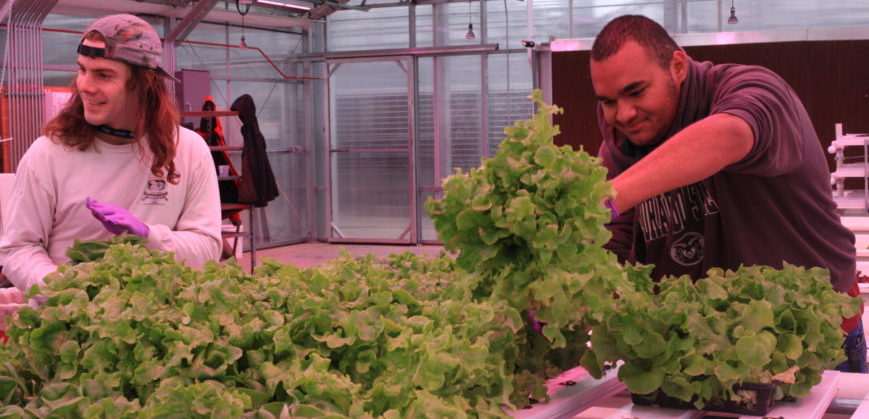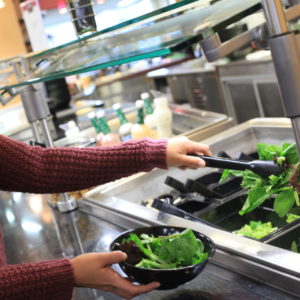Residential dining centers embrace Farm to Table
by Sylvia Cranmer | December 12, 2016 11:46 AM

Student volunteers, Floriculture major Evan Panter and Braiden Hall Eco Leader Evan Torres, right, help Horticultural Center staff harvest lettuce destined for salad bars in residential dining centers.
A fresh, contemporary concept in dining is hitting the residential dining centers on campus. CSU’s Housing & Dining Services is embracing the farm-to-table concept, expanding fresh, local and sustainable food options for students.
CSU recently started serving freshly grown, hand-picked lettuce from on-campus greenhouses. Corbett/Parmelee and Durrell Dining Centers are serving the greens, which are grown in six different hydroponic tables located at CSU’s new Horticulture Center on Centre Avenue.
The initiative has been brewing since about 2010, when Residential Dining Services was looking for a location to grow herbs for the dining centers. At that time, undergraduate horticulture student Royce Lahman was working at Ram’s Horn Dining Center. In coordination with Horticulture professor Steven Newman, Lahman saw a perfect opportunity to connect the worlds of horticulture and dining while fulfilling a need on campus, and implementing the eco-friendly farm-to-table concept for food service.
“Dr. Newman and I have always had this awesome idea to provide farm-to-table food (on campus), Lahman says. “It was really a dream of both of us to connect those two worlds for collaboration.”
Lahman has since graduated and is now working full-time as the RDS Meal Access Coordinator, involved with the project he helped to establish.
Hands-on harvesting
With the construction of the new horticulture center in 2015, the opportunity to collaborate with an academic department to mix academics and dining became a reality. Student volunteers get hands-on experience harvesting the lettuce with the help of the Horticulture Center staff, and multiple varieties of lettuce find their way to dining center salad bars on a weekly basis. In one recent harvest, 193 pounds of lettuce were harvested and served. The recent cultivars have included Flandria butterhead lettuce, Cornucopia green salad bowl mix and a mixed cultivar variety.
Not only is this home-grown lettuce a healthy alternative, it also supports the university’s commitment to sustainability. Knowing where our food comes from and what went into both growing it and getting it to our plates is important on many levels, particularly when it comes to health and sustainability. It’s also a big picture, campus-wide educational opportunity.
“We want to be as sustainable as possible and drive our students to sustainable food choices,” says Lahman. “Locally grown, sustainable produce gives students and customers (of the dining centers) the opportunity to learn about programs at CSU, different growing methods, sustainable farming practices as well as the farm-to-table program benefits.”
Benefits to the university

On a larger scale, there are also many benefits to the university. Aside from providing great-tasting lettuce, CSU-grown produce provides a local product to the campus population, with the added benefit of hands-on learning and collaboration among various departments that otherwise may not cross paths.
As the farm-to-table concept gains traction, consumers are increasingly looking for these products, but it’s challenging when most of the U.S. produce is shipped to Colorado from warmer locations. One of the goals of this collaboration is to make students aware of how to grow crops closer to their consumer.
According to student volunteer Naomi Mathew, “I think the concept is an amazing idea. I feel like it gives an opportunity for new ideas to develop and that’s great. The lettuce tastes richer and fresher than what was previously served. This might sound odd, but it tastes healthier and cleaner.”
While lettuce is the first product to be entirely grown and served on campus, this initiative may expand to other products in the future.
“We do see opportunity for growth in this program…with multiple options regarding expansion that include additional crops, additional serving locations and creation of a living laboratory/course,” adds Lahman.
One consideration for expansion is adding fresh herbs or a soft fruit crop, such as tomatoes. During the summer months, an outdoor student garden may be able to offer more products as the program grows.
Source URL: https://source.colostate.edu/residential-dining-centers-embrace-farm-table/
Copyright ©2024 SOURCE unless otherwise noted.